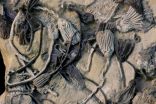(Press-News.org) Atherosclerosis is one of the commonest causes of death in modern societies. The condition is characterized by the build-up of fatty deposits called atherosclerotic plaques on the inner surfaces of arteries, which restrict, and may eventually cut off, blood flow. The deposits can also be dislodged from their site of origin and may then block major vessels in the heart or the brain, leading to life-threatening myocardial infarction or stroke.
Monocytes, an important class of white blood cells, are known to contribute significantly to the development of atherosclerosis. They are actively recruited to atherosclerotic lesions, and promote plaque development by sustaining a chronic inflammatory reaction.
Inhibition of monocyte recruitment therefore offers a way of interrupting the build-up of plaques. However, one first needs to know how the monocytes are actually localized to the vessel wall. Professor Christian Weber and Dr. Maik Drechsler of the Institute for Prophylaxis and Epidemiology of Cardiovascular Disease at LMU, in collaboration with Oliver Söhnlein of LMU and a team at the Academic Medical Center in Amsterdam, have now shown that the receptor molecules CCR1 and CCR5 are crucially involved in the process by which monocytes are recruited to the vessel wall. This process is made up of a sequence of distinct steps, including adhesion of the endothelial cells that form the arterial wall, and their subsequent transmigration into the bloodstream by infiltration between neighboring endothelial cells, following activation of the receptors by binding of their respective ligands.
The new findings correct a commonly held view of the precise function of the CCR2 receptor in the recruitment of monocytes. "In contrast to what has been assumed so far, this receptor does not mediate the infiltration of monocytes into the vessel wall; instead, like another chemokine receptor, CXCR2, it controls their mobilization from the bone marrow into the bloodstream," says Oliver Söhnlein.
The receptor molecules CCR1 and CCR5 therefore present promising targets for the development of novel approaches to the treatment of atherosclerosis, using agents that inhibit their interaction with their respective binding partners, either directly or indirectly. (nh)
###
Publication:
Distinct functions of chemokine receptor axes in the atherogenic mobilization and recruitment of classical monocytes
Oliver Soehnlein, Maik Drechsler, Yvonne Döring, Dirk Lievens, Helene Hartwig, Klaus Kemmerich, Almudena Ortega-Gomez, Manuela Mandl, Santosh Vijayan, Delia Projahn, Christoph D. Garlichs, Rory R. Koenen, Mihail Hristov, Esther Lutgens, Alma Zernecke, Christian Weber
EMBO Molecular Medicine
doi: 10.1002/emmm.201201717
Contact:
Prof. Dr. med. Christian Weber
Institute for Prophylaxis and Epidemiology of Cardiovascular Disease
Munich University Hospital
Phone: 089 / 5160 – 4350
Fax: 089 / 5160 – 4352
Email: kreislaufinstitut@med.uni-muenchen.de END
Atherosclerosis -- Monocyte migrations
2013-02-19
ELSE PRESS RELEASES FROM THIS DATE:
Eye movements reveal reading impairments in schizophrenia
2013-02-19
A study of eye movements in schizophrenia patients provides new evidence of impaired reading fluency in individuals with the mental illness.
The findings, by researchers at McGill University in Montreal, could open avenues to earlier detection and intervention for people with the illness.
While schizophrenia patients are known to have abnormalities in language and in eye movements, until recently reading ability was believed to be unaffected. That is because most previous studies examined reading in schizophrenia using single-word reading
tests, the McGill researchers ...
'Quality of life' therapy improves health during cancer treatment, Mayo Clinic finds
2013-02-19
ROCHESTER, Minn. -- Therapy to ease stress, fatigue and other quality of life issues significantly improves patients' sense of well-being during cancer treatment, new Mayo Clinic research shows. Patients who kept to their standard routines showed a decline in quality-of-life measures, the study found. The findings are published this month in Cancer.
Mayo cancer care specialists created a six-session program to address cognitive, physical, emotional, social and spiritual well-being. Each session includes physical therapy exercises to improve fatigue, discussions of topics ...
Raw meat diet may not be enough for cats (or tigers)
2013-02-19
Animal scientists say a raw meat diet is a good source of protein for cats, but pet owners may need to supplement with other nutrients.
In a new paper in the Journal of Animal Science, researchers from the University of Illinois at Urbana-Champaign and Omaha's Henry Doorly Zoo and Aquarium analyzed the value of raw meat diets for cats and exotic felids. The researchers used several tests to evaluate the nutrients in meat from bison, cattle, horses and elk.
To test how the different diets affected cats, the researchers collected blood serum and fecal samples from domestic ...
When it comes to genetic code, researchers prove optimum isn't always best
2013-02-19
COLLEGE STATION, Feb. 18, 2013 — Imagine two steel springs identical in look and composition but that perform differently because each was tempered at a different rate.
A team of researchers including a Texas A&M University molecular biologist has shown that concept — that the speed of creation affects performance — applies to how a protein they studied impacts an organism's circadian clock function. This discovery provides new insights into the significance of the genetic code for controlling the rates at which critically important proteins are synthesized, and could ...
Study: p38beta MAPK not critical to brain inflammation
2013-02-19
LEXINGTON, Ky. (Feb. 18, 2013) — A study by a leading Alzheimer's researcher at the University of Kentucky provides new evidence that will help researchers home in on the molecular mechanisms involved in inflammation of the central nervous system (CNS) and aid drug-development strategies for treating inflammatory neurological diseases.
The research was led by Linda Van Eldik, director of UK's Sanders-Brown Center on Aging, and included co-authors Bin Xing and Adam Bachstetter from the Van Eldik lab. The study demonstrated that the beta isoform of p38 mitogen-activated ...
Variations within influenza strain may explain varying patient response
2013-02-19
LOUISVILLE, Ky. – Just the mention of H1N1 can conjure up images of long lines of people waiting to be vaccinated, news reports of the severity of the pandemic and the count of the number of people who perished from the 2009-10 outbreak. However, some positives are coming forward.
Researchers at the University of Louisville have found variations within H1N1 patients who were hospitalized and identified those that most impacted patients. Their findings were published today (Feb. 18, 2013) on the PLOS ONE website.
"While all of the variants that we uncovered hijacked ...
Johns Hopkins Medicine and Fundación Santa Fe de Bogotá collaboration to focus on research, nursing
2013-02-19
An expansion of collaborative projects involving Fundación Santa Fe de Bogotá (FSFB), one of Colombia's premier health care institutions, and Johns Hopkins Medicine International (JHI) will continue for another 10 years under an agreement signed Feb. 18, 2013, in Baltimore, USA. The collaboration agreement detailing joint efforts in research and nursing, among other areas, was signed by Steven J. Thompson, chief executive officer of JHI, and Juan Pablo Uribe, chief executive officer of FSFB.
"It is a privilege to have the opportunity to strengthen our collaboration with ...
Ancient fossilized sea creatures yield oldest biomolecules isolated directly from a fossil
2013-02-19
COLUMBUS, Ohio—Though scientists have long believed that complex organic molecules couldn't survive fossilization, some 350-million-year-old remains of aquatic sea creatures uncovered in Ohio, Indiana, and Iowa have challenged that assumption.
The spindly animals with feathery arms—called crinoids, but better known today by the plant-like name "sea lily"—appear to have been buried alive in storms during the Carboniferous Period, when North America was covered with vast inland seas. Buried quickly and isolated from the water above by layers of fine-grained sediment, their ...
It's off to work we go
2013-02-19
This press release is available in French.
Montreal, February 18, 2013 – In a large city like Montreal, public transit provides us with options for getting to work or school and back home again. In deciding to choose traffic jams over metro delays, or to pay for parking rather than buy a monthly pass, you weigh the pros, cons and costs of your options, and your mental calculations are more complicated than they may appear at first glance.
In a paper recently published in The Journal of Transportation and Land Use, Zachary Patterson, an assistant professor in Concordia ...
Solar sponge' soaks up CO₂ emissions
2013-02-19
CSIRO scientists have created a 'solar sponge' which captures and then releases carbon dioxide using the power of natural sunlight.
The breakthrough presents a new way to recycle CO2 emissions using renewable energy. The 'sponge' which is made from a new smart material called a MOF - metal organic framework - adsorbs carbon dioxide, but when exposed to sunlight, instantaneously releases it.
Known as dynamic photo-switching, this capture-and-release method is extremely energy efficient and only requires UV light to trigger the release of CO2 after it has been captured ...


